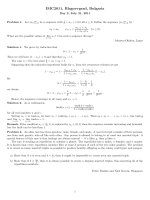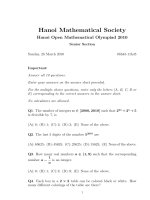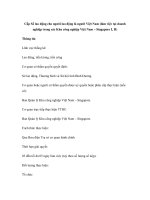Singapore Mathematical Olympiad Senior Section09
Bạn đang xem bản rút gọn của tài liệu. Xem và tải ngay bản đầy đủ của tài liệu tại đây (84.28 KB, 5 trang )
<span class='text_page_counter'>(1)</span><div class='page_container' data-page=1>
Singapore Open Mathematical
Olympiad 2009
Senior Section
Tuesday, 2 June 2009 0930-1200 hrs
Important:
Answer ALL 35 questions.
Enter your answer sheet provided.
For the multiple choice questions, enter your answer on the answer sheet by
shading the bubble containing the letter (A, B, C, D or E) corresponding to the
correct answer
For the other short questions, write your answer in the answer sheet
No steps are needed to justify your answer
Each question carries 1 mark
No calculators are allowed.
Multiple Choice Questions
Question 1. Suppose thatπ is a plane andAand B are two points on the plane
π. If the distance between A and B is 33 cm, how many lines are there in the
plane such that the distance between each line and A is 7 cm and the distance
between each line and B is 26 cm, respectively.
(A) 1 (B) 2 (C) 3 (D) 4 (E) infinitely many
Question 2. Lety= (17−x)(19−x)(19 +x)(17 +x), where xis a real number.
Find the smallest posible value of y.
(A) -1296 (B) -1295 (C) -1294 (D) -1293 (E) -1292
Question 3. If two real numbersaand b are randomly chosen from the interval
(0,1), find the probability that the equationx2−√ax+b= 0 has real roots.
(A) 1
8 (B)
5
16 (C)
3
16 (D)
1
4 (E)
</div>
<span class='text_page_counter'>(2)</span><div class='page_container' data-page=2>
Question 4. If x and y are real numbers for which |x| +x + 5y = 2 and
|y| −y+x= 7, find the value ofx+y.
(A) -3 (B) -1 (C) 1 (D) 3 (E) 5
Question 5. In a triangle ABC, sinA = 3
5 and cosB =
5
13. Find the value of
cosC.
(A) 56
65 or
16
65 (B)
56
65 (C)
16
65 (D) −
56
65 (E)
56
65 or−
16
65
Question 6. The area of a triangle ABC is 40 cm2. Points D, E and F are on
sidesAB,BCand CA, respectively, as shown in the figure below. IfAD= 3 cm,
DB = 5 cm, and the area of triangle ABE is equal to the area of quadrilateral
DBEF, find the area of triangle AEC in cm2.
(A) 11 (B) 12 (C) 13 (D) 14 (E) 15
Question 7. Find the value of 3
1! + 2! + 3!+
4
2! + 3! + 4!+· · ·+
22
20! + 21! + 22!.
(A) 1− 1
24! (B)
1
2−
1
23! (C)
1
2 −
1
22! (D) 1−
1
22! (E)
1
2−
1
24!
Question 8. There are eight envolopes numbered 1 to 8. Find the number of
ways in which 4 identical red buttons and 4 identical blue buttons can be put in
the envolopes such that each envolope contains exactly one button, and the sum
of the nimbers on the envolopes containing the blue buttons.
(A) 35 (B) 34 (C) 32 (D) 31 (E) 62
Question 9. Determine the number of acute-angled triangles (i.e., all angles are
less than 90’) in which all angles (in degrees) are positive integers and the largest
angle is three times the smallest angle.
(A) 3 (B) 4 (C) 5 (D) 6 (E) 7
Question 10. Let ABCD be a quadrilateral inscribed in a circle with diameter
AC, and let E be the foot of perpendicular from D onto AB, as shown in the
figure below. If AD=DC and the area of quadrilateral ABCD is 24 cm2, find
the length of DE in cm.
</div>
<span class='text_page_counter'>(3)</span><div class='page_container' data-page=3>
Short Questions
Question 11. Find the number of positive divisors of(20083+(3×2008×2009)+
1))2.
Question 12. Suppose that a, bandcare real numbers greater than 1. Find the
value of
1
1 + log<sub>a</sub>2<sub>b</sub> <sub>a</sub>c
+
1
1 + log<sub>b</sub>2<sub>c</sub> a<sub>b</sub>
+
1
1 + log<sub>c</sub>2<sub>a</sub> b<sub>c</sub>
·
Question 13. Find the remainder when(1!×1)+(2!×2)+(3!×3)+· · ·+(286!×286)
is divided by 2009.
Question 14. Find the value of
(25 + 10√5)13 + (25−10
√
5)13.
Question 15. Let a= 1 +
√
2009
2 . Find the value of (a
3<sub>−</sub><sub>503</sub><sub>a</sub><sub>−</sub><sub>500)</sub>10<sub>.</sub>
Question 16. In the figure below, ABC is a triangle and D is a point on side
BC. Point E is on side AB such that DE is the angle bisector of ∠ADB, and
point F is on side AC such that DF is the angle bisector of ∠ADC. Find the
value of AE
EB
BD
DC
CF
F A·
Question 17. Find the value of
(cot 250−1)(cot 240−1)(cot 230−1)(cot 220−1)(cot 210−1)(cot 200−1).
Question 18. Find the number of 2-element subset{a, b}of{1,2,3, . . . ,99,100}
such that ab+a+bis a multiple of 7.
Question 19. Letx be real number such thatx2−15x+ 1 = 0. Find the value
of x4+ 1
x4·
Question 20. In the figure below,ABC is a triangle withAB= 10cm,BC = 40
</div>
<span class='text_page_counter'>(4)</span><div class='page_container' data-page=4>
parallel toAB and DF is parallel to EB. Given thatBE is an angle bisector of
∠ABC and thatAD= 13.5 cm, find the length ofCD in cm.
Question 21. Let S = {1,2,3, . . . ,64,65}. Determine the number of ordered
triples(x, y, z) such that x, y, z∈S,x < z and y < z.
Question 22. Given that an+1 =
an−1
1 +nan−1an
, where n= 1,2,3, . . ., and a0 =
a1= 1, find the value of
1
a199a200
·
Question 23. In the figure below,ABC is a triangle withAB= 5cm, BC= 13
cm andAC = 10cm. PointsP and Qlie on sides AB and AC respectively such
that area of∆AP Q
area of∆ABC =
1
4·Given that the least posible length ofP Qiskcm, find
the value ofk.
Question 24. Ifx, yare real numbers such thatx+y+z= 9andxy+yz+zx= 24,
find the largest possible value of z.
Question 25. Find the number of0−1binary sequences formed by six00s and10s
such that no three00s are together. For example, 110010100101 is such a sequence
but 101011000101 and 110101100001 are not.
Question 26. If cos 100
0
1−4 sin 250<sub>cos 25</sub>0<sub>cos 50</sub>0 = tanx, findx.
Question 27. Find the number of positive integersx, wherex6= 9, such that
logx
9
x2
3
<6 + log<sub>3</sub>
9
x.
Question 28. Letn be the positive integer such that
1
9√11 + 11√9+
1
11√13 + 13√11+
1
13√15 + 15√11+· · ·+
1
n√n+ 2 + (n+ 2)√n =
1
9·
Find the value of n.
</div>
<span class='text_page_counter'>(5)</span><div class='page_container' data-page=5>
Question 30. In each of the following 6-digit positive integers: 555555, 555333,
818811, 300388, every digit in the number appears at least twice. Find the number
of such 6-digit positive integers.
Question 31. Let xand y be positive integers such that 27x+ 35y6945. Find
the largest posible value ofxy.
Question 32. Determine the coefficient ofx29in the expansion(1+x5+x7+x9)16.
Question 33. Forn= 1,2,3, . . ., letan=n2+100, and letdndenote the greatest
common divisor of an and an+1. Find the maximun value ofdn asn ranges over
all positive integers.
Question 34. Using the digits1,2,3,4,5,6,7,8,we can form8!(=40320) 8-digit
numbers in which the eight digits are all distinct. For 1 6 k 6 40320, let ak
denote the hth number if these numbers are arranged in increasing order:
12345678,12345687,12345768, . . . ,87654321;
that is,a1 = 12345678,a2 = 12345687,. . .,a40320= 87654321. Finda2009−a2008.
Question 35. Let x be a positive integer, and write a = blog<sub>10</sub>xc and b =
log<sub>10</sub>100<sub>x</sub> . Herebccdenotes the greatest integer less than or equal toc. Find the
largest possible value of 2a2−3b2.
</div>
<!--links-->









